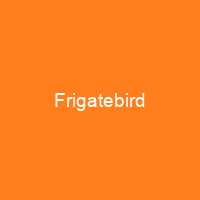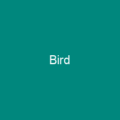Frigatebirds are a family of seabirds called Fregatidae which are found across all tropical and subtropical oceans. The five extant species are classified in a single genus, Fregata. All have predominantly black plumage, long, deeply forked tails and long hooked bills.
About Frigatebird in brief
 Frigatebirds are a family of seabirds called Fregatidae which are found across all tropical and subtropical oceans. The five extant species are classified in a single genus, Fregata. All have predominantly black plumage, long, deeply forked tails and long hooked bills. Females have white underbellies and males have a distinctive red gular pouch, which they inflate during the breeding season to attract females. Their wings are long and pointed and can span up to 2. 3 metres, the largest wing area to body weight ratio of any bird. Frigatebirds are referred to as kleptoparasites as they occasionally rob other seab birds for food, and are known to snatch seabird chicks from the nest. A rough nest is constructed in low trees or on the ground on remote islands. A single egg is laid each breeding season; frigatebirds only able to breed every other year. The oldest fossils date to the early Eocene, around 50 million years ago. The English term is derived from the French mariners’ name for the bird la frégate—a frigate or fast warship. Christopher Columbus encountered frigatebird when passing the Cape Verde Islands on his first voyage across the Atlantic in 1492. In the Caribbean frigate birds were called Man-of-War birds by English mariners. This name was used by the English explorer William Dampier in his book An Account of a New Voyage Around the World published in 1697: The Man- of-War is about the bigness of a Kite, and in shape like it, but black; and the neck is red.
Frigatebirds are a family of seabirds called Fregatidae which are found across all tropical and subtropical oceans. The five extant species are classified in a single genus, Fregata. All have predominantly black plumage, long, deeply forked tails and long hooked bills. Females have white underbellies and males have a distinctive red gular pouch, which they inflate during the breeding season to attract females. Their wings are long and pointed and can span up to 2. 3 metres, the largest wing area to body weight ratio of any bird. Frigatebirds are referred to as kleptoparasites as they occasionally rob other seab birds for food, and are known to snatch seabird chicks from the nest. A rough nest is constructed in low trees or on the ground on remote islands. A single egg is laid each breeding season; frigatebirds only able to breed every other year. The oldest fossils date to the early Eocene, around 50 million years ago. The English term is derived from the French mariners’ name for the bird la frégate—a frigate or fast warship. Christopher Columbus encountered frigatebird when passing the Cape Verde Islands on his first voyage across the Atlantic in 1492. In the Caribbean frigate birds were called Man-of-War birds by English mariners. This name was used by the English explorer William Dampier in his book An Account of a New Voyage Around the World published in 1697: The Man- of-War is about the bigness of a Kite, and in shape like it, but black; and the neck is red.
It lives on Fish yet never lights on the water, but soars aloft like a Kites, and when it sees its prey, it flys down head foremost to the Waters edge, very swiftly takes its prey out of the Sea with his Bill, and immediately mounts again as swiftly; never touching the Water with hisBill. It is a sister group to Suloidea which consists of cormorants, darters, gannets, and boobies. Three of the five species are widespread, while two are endangered and restrict their breeding habitat to one small island each. The term Frigate Bird itself was used in 1738 by theEnglish naturalist and illustrator Eleazar Albin in his A Natural History of the Birds. The genus F Regata was defined by French naturalist Germain de Lacépède de Tachypéde in 1816 for the great great frigate bird. The German naturalist Paul Möhring coined the name Atagenetes in 1752, though this has no validity as predates the official taxonomy of the family. Not74, English zoologist Alfred Henry Garrod published a study where he examined a selected group of five groups of birds and recorded which muscles they lacked.
You want to know more about Frigatebird?
This page is based on the article Frigatebird published in Wikipedia (as of Nov. 07, 2020) and was automatically summarized using artificial intelligence.







